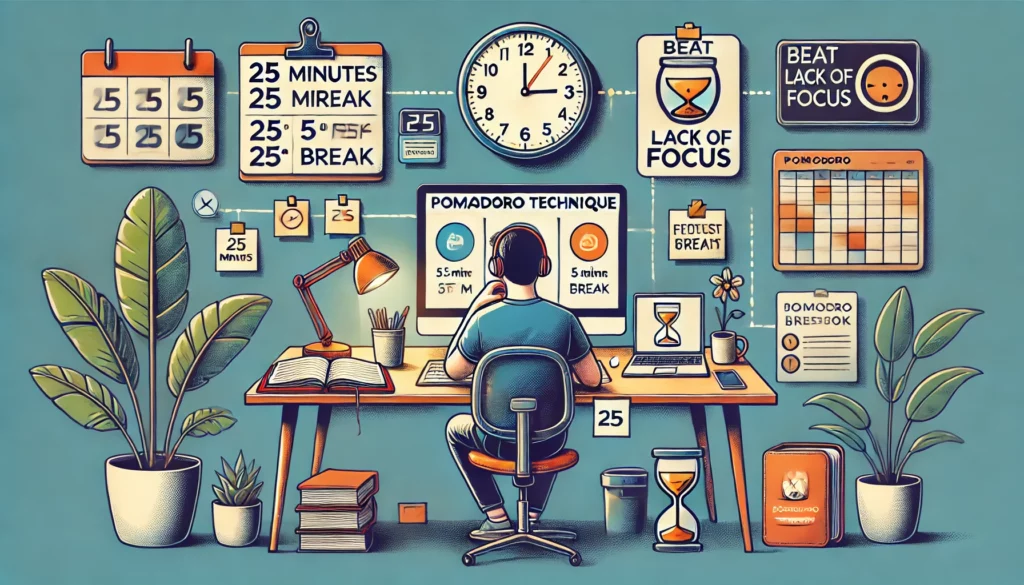If you often find yourself distracted while working—checking your phone, browsing social media, or losing focus after just a few minutes—you’re not alone. In today’s fast-paced world, staying focused for long periods can feel like an uphill battle. That’s where the Pomodoro Technique comes in.
This simple yet powerful method helps you work in short, focused intervals, followed by brief breaks. It’s designed to keep your mind fresh, boost concentration, and help you make steady progress without burning out.
In this guide, you’ll learn exactly how the Pomodoro Technique works, why it’s so effective, and how you can use it in your daily routine to get more done with less stress.
What Is the Pomodoro Technique?
Developed by Francesco Cirillo in the late 1980s, the Pomodoro Technique is based on the idea that we focus better when we work in short bursts. The method uses timed intervals called “Pomodoros,” which are followed by regular breaks to give your brain a chance to reset.
Here’s how a standard Pomodoro cycle works:
- Work on one task for 25 minutes
- Take a 5-minute break
- Repeat the cycle four times
- After the fourth Pomodoro, take a longer break of 15 to 30 minutes
This cycle prevents mental fatigue, reduces distractions, and makes it easier to stay productive throughout the day.
Why the Pomodoro Technique Is So Effective
Many people think they need long, uninterrupted hours to be productive. But studies show that working in shorter sessions with regular breaks actually improves performance.
Here’s why it works so well:
- Short focus periods help prevent burnout
- Frequent breaks keep your energy and motivation up
- Time limits encourage urgency and reduce procrastination
- Working on one task at a time improves concentration
By using this technique, you train your mind to work with intention and recover often—leading to better results with less stress.
How to Start Using the Pomodoro Technique
1. Set Up a Workspace That Supports Focus
Before you begin a Pomodoro session, create an environment that allows you to work without interruptions. That means turning off unnecessary notifications, closing unused browser tabs, and setting clear boundaries with those around you.
Make sure your space is quiet and clutter-free. If you prefer some background sound, instrumental music or white noise can help reduce external distractions.
2. Choose a Specific Task to Work On
Clarity is essential for a productive Pomodoro session. Instead of choosing a vague task like “work on the project,” break it down into something more specific, like “write the introduction of the report” or “answer five client emails.”
Clear, focused tasks help you avoid decision fatigue and make the session more productive from the start.
3. Use a Timer to Stay on Track
Using a timer is the core of the Pomodoro Technique. You can use a physical timer, your phone’s timer (on Do Not Disturb mode), or an app made for Pomodoro cycles. The key is to stick to the time limits and avoid checking the clock constantly.
When the timer starts, focus solely on your task. No multitasking, no switching to other work—just one task for 25 minutes.
4. Follow the Classic Pomodoro Cycle
Stick to the original structure:
- Work for 25 minutes
- Take a 5-minute break
- After four sessions, take a longer break of 15–30 minutes
These breaks are not just rest periods—they’re a chance to refresh your mind so you can return to work with renewed focus. During your breaks, avoid screens. Instead, stand up, stretch, drink water, or take a short walk.
5. Customize the Time Blocks to Fit Your Style
The classic 25/5 timing works well for many people, but you can adjust the intervals based on the type of work you’re doing or your personal focus limits.
Try these variations:
- 50 minutes work, 10 minutes break – for deep work sessions
- 90 minutes work, 30 minutes break – for creative or strategic tasks
- 15 minutes work, 3 minutes break – for quick admin tasks or when just getting started
The goal is to find the rhythm that helps you stay engaged without feeling drained.
Mistakes to Avoid When Using the Pomodoro Technique
Although the Pomodoro Technique is simple, there are a few common mistakes that can reduce its effectiveness:
- Skipping breaks: It’s tempting to keep working when you’re in the zone, but breaks are essential for maintaining focus throughout the day.
- Multitasking: Each Pomodoro should be dedicated to one task only. Switching tasks mid-session breaks your concentration.
- Choosing tasks that are too large: If a task takes more than a few sessions, break it down into smaller, actionable parts.
- Not tracking your sessions: Seeing how many Pomodoros you complete each day can be incredibly motivating. Use a notebook or app to keep track.
How Pomodoro Can Help in Different Areas of Life
The Pomodoro Technique isn’t just for work. It can be applied to all areas where focus and consistency matter.
- Studying: Improve retention by alternating focused study sessions with breaks
- Writing: Prevent writer’s block by dividing writing into manageable sessions
- Reading: Stay focused on long reading tasks by taking regular pauses
- Housework: Make cleaning more manageable by tackling one area at a time
- Exercise: Stay consistent by committing to short, timed workouts
It’s a flexible method that helps you stay committed without feeling overwhelmed.
Final Thought: Turn Focus into a Habit
The Pomodoro Technique is more than a productivity hack—it’s a tool that helps you work with intention and build focus as a habit. By structuring your time into short sessions and giving yourself permission to rest, you avoid burnout, reduce procrastination, and get more done in less time.
Start small. Choose one task you’ve been putting off. Set a timer for 25 minutes. Then focus, without distractions, until the timer rings.
Once you experience how much progress can happen in a single Pomodoro, you’ll understand just how powerful this simple system can be.
Gabriel Silva is the founder of Cursos e Soluções, a blog dedicated to personal growth, habit change, and self-discipline. Passionate about self-development and productivity, he shares practical, research-backed strategies to help people achieve their goals. He believes that small, consistent changes can lead to significant transformations over time and is committed to providing content that empowers both personal and professional success.







